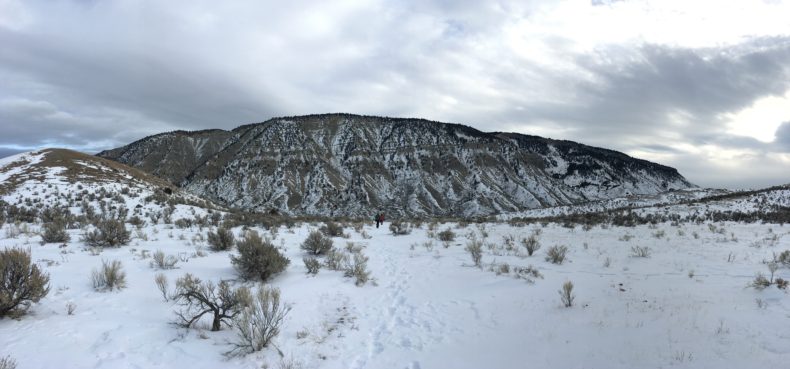
Long ago, when I was a graduate student in English, I was charged with teaching a class of first-year students how to write “academically.” (Poor things.) One essay I chose for them from the beefy course reader was “The Loss of the Creature,” by the novelist Walker Percy. Briefly, Percy argues that we have lost our ability to see the essence of things. So many of our experiences come to us thoroughly pre-packaged that we gauge our pleasure by the degree to which the experience aligns with our expectations. “[T]he thing as it is,” he writes, “has been appropriated by the symbolic complex which has already been formed in the sightseer’s mind.”
I was thinking of Percy and his discontents a few weeks ago while I drove on I-90 through eastern Washington with my wife, daughter, and mother-in-law. It was the start of my daughter’s winter break and we were off to Yellowstone National Park. I don’t go out of my way to visit national parks, but my daughter is in fourth grade and the National Park Service, taking a sort of “Give Me the Child and I Will Show You the Man” approach to wilderness appreciation, offers free admission for fourth graders. So to Yellowstone we were bound.
To make the trip an occasion we had rented a van that had more names than a member of the British royal family: a Mercedes Sprinter Storyteller Overlander BeastMODE 4×4. Its owners had shortened that to Serenity, which they stenciled on the side above some Chinese characters. Serenity was a stew of semiotic psychoses. Here we were, cosseted in an exemplar of wild, carefree, adventure-loving, planet-hugging #VanLife, all to the tune of fifteen miles per gallon. I spent a lot of the drive calculating the veritable forests we’d have to plant to offset the effects of this monstrosity. In the end I figured that, as middle-class Americans, if we truly wanted to lessen our impact on the planet, then the surest way to do that, sensu Camus, would be to kill ourselves. But it was the holidays, and we were leaving the Cascadia bioregion for the first time in two years, en route to one of the country’s most stunning national parks, and so I resolved to think happy thoughts.
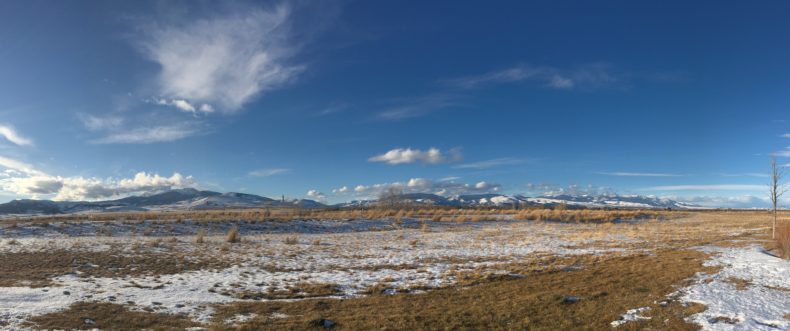
Percy wrote “The Loss of the Creature” in 1958 and included it in his collection, The Message in the Bottle, which he published in 1975. The collection is broadly concerned with Percy’s “recurring interest” in “the nature of communication and, in particular, man’s unique discovery of the symbol.”
In “The Loss of the Creature” his topic is tourism, and to a lesser extent education. His bête noire is the “picture postcard”: the perfect image, taken in impossible light with nary a person in sight, which serves as flypaper for a tourist’s hopes and dreams. “The highest point, the term of the sightseer’s satisfaction… is rather the measuring up of the thing to the criterion of the preformed symbolic complex,” he writes. “If it does so, if it looks just like the postcard, he is pleased; he might even say, ‘Why it is every bit as beautiful as a picture postcard!’”
Woe betide the tourist so suckered, however, for the pleasure they derive is both fleeting and false. “The sightseer may be aware that something is wrong,” Percy writes. “He may simply be bored; or he may be conscious of the difficulty: that the great thing yawning at his feet somehow eludes him. The harder he looks at it, the less he sees.”
For Percy, the solution is to “recover” the site, wresting it from its symbolic complex. To do that the tourist must leave “the beaten track.” Leaving the beaten track might be as simple as camping in the backcountry rather than joining a bus tour. It might be waiting for a typhus outbreak to close the park and sneaking in then. Or it could be visiting in the dead of winter, when fewer people are around. Even doing that, I knew we would have to be on our toes if we were to have a Percy-approved visit. Get too far from the beaten track in a national park, and you’re liable to face a hefty fine.
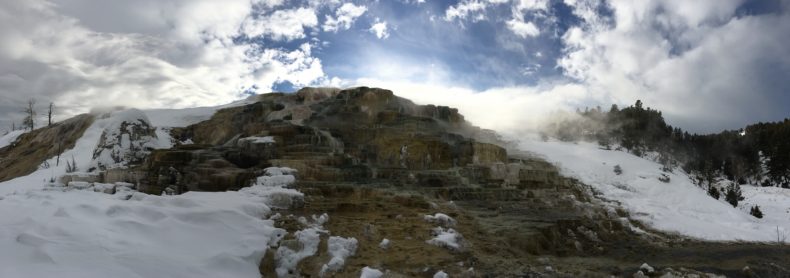
A day later we rolled into the park’s northeast entrance, in Gardiner, Montana. We presented ourselves and our fourth grader to the park ranger, who gave us a map and waved us through. The thermometer hanging outside her window read 21 ºF. “Have a great time!” she said.
Yellowstone largely shuts down during the winter. The only open campground is Mammoth Hot Springs, about five miles from Gardiner. Naturally we had our pick of sites, and once settled we put on all our layers and trudged up the road to the hot springs, ready to experience the park in near splendid isolation. But Mammoth was bustling. As a site it has not only the springs, but also a large hotel, some administrative offices, a visitor center, a gas station, a general store, restrooms. Dozens of people were milling around, and then a snow coach with absurdly large tires rumbled past like a monster truck. It stopped outside the hotel and disgorged a load of skiers. We moved through the happy scrum and ducked into a gift shop. My mother-in-law bought my daughter a stuffed bison, which she duly named “Yellowstone.”
We continued up to the hot springs, called the Terraces. Signs warned us not to stray from the boardwalks lest we boil to death in the scalding water. The air reeked of sulfur. The complex, said a sign, formed thousands of years ago, and is “a surface expression of the deep magmatic forces at work in Yellowstone.” Heated water courses up through the limestone, bearing with it calcium carbonate in solution. When it reaches the surface carbon dioxide is released into the air, leaving the calcium carbonate to be deposited as travertine. Thermophilic bacteria color the scene to complete it. “No human architect ever designed such intricate fountains as these,” read one account. “The water trickles over the edges from one to another, blending them together with the effect of a frozen waterfall.”
I wanted to capture something of the marvel, but people kept stepping into my shot. I persevered, snapping photos whenever there were gaps in the groups. Lying in Serenity later after everyone else was asleep, I swiped through my efforts. There were a few nice ones of the steaming terraces backlit by a worthless sun, but the picture I most liked was of some mountains to the north. I had managed to make it look like I was all alone on a wide snowy plain, the peaks looming in the distance under dramatic clouds. Perfect.
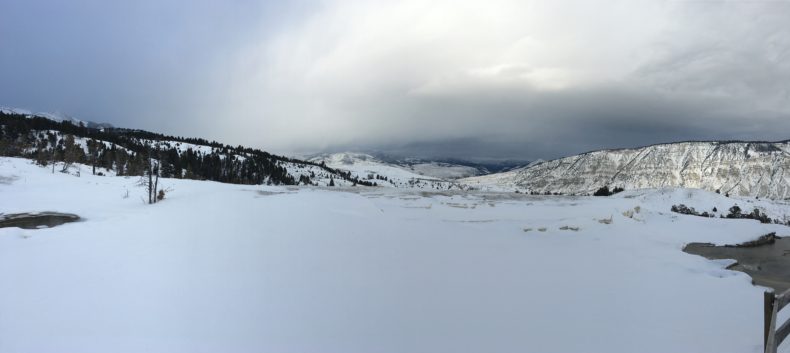
Percy spends much of his essay writing about the Grand Canyon, but he just as easily could have written about Yellowstone. It might have been better, actually. As the oldest national park it was, I was often reminded, “the granddaddy of them all,” and thus the prime inhibitor of the sense of “discovery” that Percy wants us to seek.
Now, of course, that sense of “discovery” is embarrassing and offensive. In the visitor center we saw attempts to balance the term’s spiritual connotations—the old (wonder) and the new (shame). Among the large museum-like displays on Yellowstone’s history, for instance, was a panel listing the names of the many indigenous groups who live in the area, over whose bodies the land had been so violently “discovered.”
The sin dwelt on most, though, was the slaughter of the bison, from the millions that once roamed the Great Plains down to just a couple of dozen in Yellowstone. Pictures showed immense piles of skulls slated to become the fertilizer that helped farmers displace the tribes. Next to these were excerpts from journals of beleaguered game wardens, or news articles about U.S. Army troops deployed to the park to stop wanton poaching once bison conservation became a goal. The Yellowstone herd now numbers more than 5,400 animals and is the largest in the country. This factoid was meant to alleviate the despair, I guess.

A couple of days later we went to hike at a place called Lost Lake. This obliged us to drive deeper into the park, to the Roosevelt Lodge and Cabins near Tower Falls. The lodge was closed and walking up the empty road past empty cabins was deliciously eerie; I felt like an extra in a post-apocalyptic movie. (Percy would have approved, since one of his recovery scenarios is for survivors of a massive national disaster to visit depopulated tourist hotspots and revel in their solitude.)
A map at the trailhead showed the loop, which was three miles long, with the lake about halfway. Lost Lake, I thought with a snort. If it’s lost why is it on a map? And only a couple of miles from a big ol’ camp IN THE MIDDLE OF A NATIONAL PARK? Blessedly I didn’t say any of this out loud. After days immersed in the tensions between Yellowstone and its symbolic complex, my frame of mind was what my wife calls Peak English Major, wherein the world is a text, and that text is full of contradictions, inconsistencies, and outright hypocrisies, and it is my duty—nay, my pleasure—to point them all out as snidely as I can.
But no: happy thoughts. We started up the trail. The snow was unsullied by footprints; we were the first people to go this way at least since the last snowfall more than a week ago. We plodded up and up through spare snowy forest for more than a mile until we reached a bench, where the sun hit us. The trees sparkled, the branches jeweled with finches.
At a junction we turned and hiked until we saw the lonely shore of Lost Lake. The lake was long and thin and gray with ice. We were joking about trying to walk across that ice when we rounded a corner and saw before us six enormous bison. They were arrayed across a hillside, grazing. The closest was maybe a hundred yards away. We could hear them snorting in a mild, gustatory way.
“Holy cow,” I breathed. We gathered behind a fallen tree and watched. The bison were angling up the hill and I thought they would all vector around us, but the one closest to the lake—and to us—seemed to be taking a more direct path our way.
My daughter immediately noted this. “That one’s coming right at us,” she whispered.
“I think we’re okay,” I said.
The bison snuffled a bush and plodded on. It wasn’t angling off with the others.
“Let’s get out of here,” my daughter said.
I demurred. I had no intention of becoming one of those Yellowstone Cautionary Animal Tales I sometimes chuckle over, but we would never have another experience like this. “We’re fine,” I said, as if I knew the ins and outs of the bison mind. “But, sure, let’s move back a bit.”
We retreated fifty yards. The big bison kept to the trail. Then another joined it. Now the two were moving toward us. “They’re following us!” my daughter whisper-hissed. “Let’s go let’s go let’s go!”
“They aren’t following us, Bug,” I said. “They’re just…” I trailed off. If they weren’t following us, they were definitely following the trail to where we were.
The two bison reached the fallen tree. The first vigorously rubbed against it. Then it stood and sniffed the air and looked at us and started walking again.
“Please let’s go!” my daughter keened, bouncing up and down on her toes. “Please please please please please please pleeeeeeease!”
We turned around. As we walked we kept telling our daughter how lucky we were, how lucky she was. “Do you have any idea how many people would love to run into a bunch of bison on a hike all by themselves?” we said. “That was amazing!”
“I don’t care!” she said, dragging me by the sleeve. For us, the jaded adults, the encounter had been a breathtaking tableau; for her, the 50 lb. child, an interaction fraught with lethal promise. All the way to the trailhead she kept looking over her shoulder, waiting for the bison to thunder over the bench and down upon our heads. But we made it back to Serenity without incident.
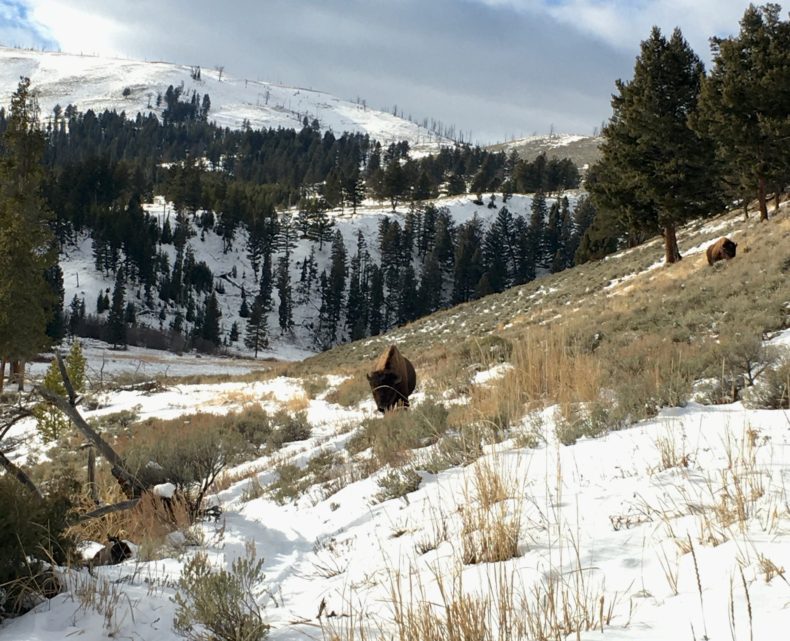
My students, as I recall, had mixed feelings about Percy. On the one hand they agreed that it was hard to experience anything for the first time anymore. But they also said he was a snob, and they weren’t convinced of the inherent evil of the symbolic complex. Of course things come with expectations! they said. And of course people like to take nice pictures and show them off! How arrogant do you have to be to think you can only appreciate something if you’re the first person to find it?
Mostly they objected to Percy’s prescriptivist approach. An essay supposedly about thinking for yourself was all about telling you how to think. I felt a bit lost when they said this. I had been prepared to discuss how the essay came out well before a rich literature sprouted up problematizing the idea of an unspoiled wilderness, and so on. That would have been safer ground for me. But my students were attuned to other resonances. Bear in mind that Percy was writing well before social media was a thing, and in the early 2000s we were all still relatively innocent in that way. Facebook was just a gleam in Mark Zuckerberg’s eye, to say nothing of Instagram (and #VanLife).
My students could sense it coming, I think: the overwhelming pressure to make life appear seamless and wonderful, to be an influencer, a walking symbolic complex. They were the ones standing on the beach of burgeoning self-regard when the ocean suddenly, ominously receded. Who, then, was Percy to tell them how to feel? Who was he to determine what was or wasn’t authentic? Who was he to dictate the conditions under which they should experience awe or terror?
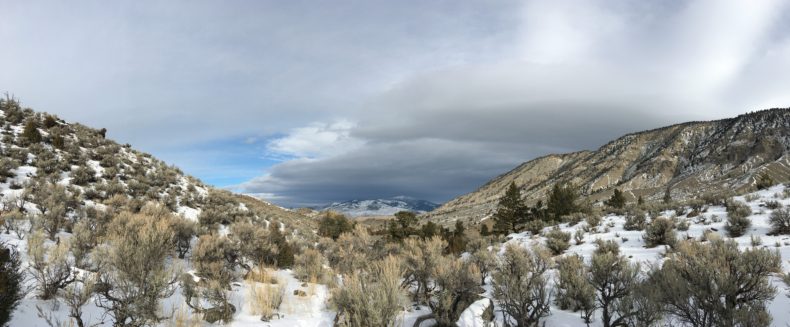
We stayed for another day and enjoyed another hike down to a river that a ranger had recommended. The trail was technically closed, but she blithely told me to ignore the warnings. “You’ll have it all to yourselves,” she said, and we did.
Then it was time to leave. On our way out we stopped at a small bookstore and café in Gardiner so I could get a cup of coffee. While waiting for it, I perused the shelves. They were full of beautiful Yellowstone coffee table books and small press offerings: Seasons in the Wild: One Family’s Story, or Alone in the Wilderness: A Woman Survives Two Winters in Yellowstone. That sort of thing.
Next to them was a rack of bookmarks. I flipped through until I found one that showed nine bison walking in a line across a snowy meadow. Far in the background was fringe of dark forest rising up snowy hills, all under a blank white sky.
“Do you want it?” I asked my daughter, because I am the sort of father who can’t let things go.
“No,” she said curtly.
So I bought it for myself. I liked its desolation, the bison marching across the landscape like survivors of some disaster, which in a sense they were. A few hundred miles later, bedded down in Serenity at a rest stop near the Idaho border, I took it out and considered it while everyone else slept. On the back the photographer had written, “I hope Yellowstone captures your heart and inspires you to chase your dreams as it has mine!” Contented, I tucked it back in my book, snuggled into my sleeping bag, and let my thoughts drift to Lost Lake. The bookmark wasn’t a picture I had taken, or even a scene I had seen. But it could have been.

All photos by the author, except for the last one, which is by Lisa Culpepper.
Thanks, Eric! I keep coming back to your beautiful question–“They were the ones standing on the beach of burgeoning self-regard when the ocean suddenly, ominously receded. Who, then, was Percy to tell them how to feel?” I also taught freshman composition for a few years, and I often had the feeling of poking at them, trying to get them to think (and feel) differently about things that they thought were perfectly good. To shake them up, I swerved between perfectly earnest–“here’s Barry Lopez & Annie Dillard & Alice Walker”–and outlandish. A teaching advisor of mine, an esteemed professor of Rhetoric and Composition, suggested that maybe what my students needed was to experience Remote Viewing. If my advisor had called it Extra Sensory Perception, I wouldn’t have done it, but that is what it is.
So there I was, my first year teaching, standing in front of a bunch of freshman probably wearing football sweatshirts, asking them to divine somehow the image on a piece of paper they hadn’t seen. A piece of paper, I’d glanced at, then ceremoniously folded and placed down on the podium. Somehow, we’d work our way to that old Tiffany lamp or a silver spoon. I always went with the ornate, the Edwardian, something they wouldn’t encounter in their daily lives. Perhaps, I wanted them to question my sanity. Remote Viewing appealed to me. For it’s cold-war sounding name, it’s seeming to scientifically sanction the ridiculous. With this nudge, I thought they’d be on their way to becoming better readers, writers, & thinkers. In teaching, as in parenting, we do what we can with the tools we have.
Oops! I can’t talk about teaching first-year composition without making at least 3 grammatical errors.
Thanks, Rachel! Ah, it definitely wouldn’t be a note about first-year Exposition: Composition without at least a few grammatical errors. Thankfully I put my grading rubric in a dark cupboard long ago, so I didn’t even notice.
I probably should have tried Remote Viewing in my class. Instead I zeroed in on the second half of “The Loss of the Creature,” where Percy discusses the relative merits of dissecting a dogfish on a beach or in a biology lab. I didn’t have access to any dead dogfish, and there was no way the department would let me take everyone to a beach, but what I *could* do was go downtown to Pike Place Market and buy some fresh seafood; and having the students poke and prod at dead, stinky specimens in a writing class seemed like an adequate compromise. So I brought a couple of Dungeness crabs and a bag of Japanese oysters and tossed them on the table before my shocked pupils and had them write about the encounter. They were pretty confused but good sports about it, and it definitely came up in my evals as “one of the most unusual assignments [they’d] ever had.” Which I guess was a good thing? All I know is I ate pretty well that night!
Thanks, Eric! I love this story. We should all be first-year teachers in something like our first-year teaching–so willing to try anything. Percy’s essay and your exercise with the crabs and oysters, made me want to ask–Have you read John Steinbeck’s “The Sea of Cortez?” Steinbeck spent some time on a research trip through the Gulf of California with a marine biologist, and they cowrote a book about what they saw. Steinbeck, like Percy, is thinking about how we observe creatures, & how we might approach the idea of what is real–specimen scooped from “an evil smelling jar” vs. a fish that “strikes hard on the line so that our hands are burned” and later “sounds and nearly escapes and finally comes in over the rail … colors pulsing and tail beating the air.” Anyway, such a good book, I’d recommend it to everyone.
Hi, Rachel! I have read the Sea of Cortez! And I love(d) it (and also Steinbeck’s accompanying The Log From…). I was actually lucky enough to read it… on the Sea of Cortez! When I was bouncing around on a research trawler looking for sperm whales and squid. We found two of each, as it happened, but not together, unfortunately. But yes, I really enjoyed SoC.